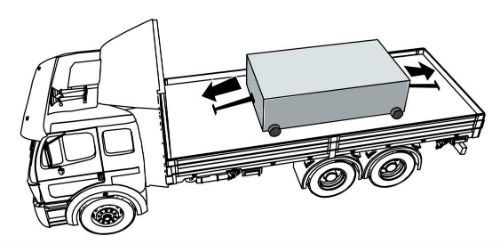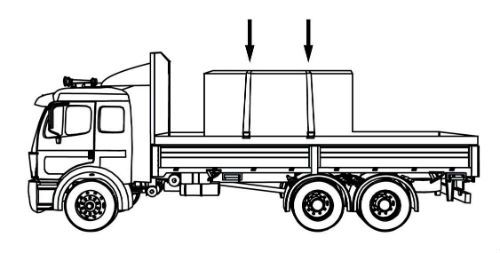CDL Practice Tests: Flatbed Cargo Securement
Choose A Section:
Go!Which of the following is not an acceptable method of containing loose parts when securing flattened or crushed vehicles?
- Suitable covering material.
- Wedge them in between the flattened cars.
- Sideboards or sides.
- Structural walls.
Containing Loose Parts
Use a containment system that:
- Prevents loose parts from falling from all four sides of the vehicle AND
- Extends to the full height of the cargo.
The containment system can consist of one or a combination of the following methods.
- Structural walls.
- Sides or sideboards.
- Suitable covering material.
The use of synthetic material for containment of loose parts is permitted.
What is the minimum nominal dimension of timber blocking used to secure concrete pipe?
- 4 x 6 in
- 2 x 4 in
- Half the diameter of the pipe
- 8 x 10 in
Blocking must be:
- Placed against the pipe
- Secured to prevent it from moving out from under the pipe.
Timber blocking must have a minimum nominal dimension of 10 x 15 cm (4 x 6 in).
An anchor point is defined as:
- The load carrying area of a truck, trailer, or intermodal container.
- A vertical barrier across the front of the deck of a vehicle to prevent forward movement of cargo.
- Part of the structure, fitting, or attachment on a vehicle or cargo to which a tiedown is attached.
- A rail along the side of a vehicle that protects the side of the vehicle from impacts.
Anchor point:
Part of the structure, fitting, or attachment on a vehicle or cargo to which a tiedown is attached.
Securing heavy vehicles or equipment with crawler tracks or wheel requires a minimum of how many tiedowns?
- It depends on the weight of the load
- 6
- 2
- 4
Special Circumstances: Securing Heavy Vehicles, Equipment, or Machinery with Crawler Tracks or Wheels
Tiedown requirements
- Restrain cargo using a minimum of four tiedowns, each having a WLL of at least 2,268 kg (5,000 lb.).
- Prevents cargo movement in the side-to-side, forward, rearward, and vertical directions.
-
Attach tiedowns:
- Either at the front and rear of the vehicle.
- Or at the mounting points on the vehicle designed for that purpose.
The load carrying area of a truck, trailer, or intermodal container is referred to as the:
- Deck
- Headboard
- Bulkhead
- Well
Deck:
The load carrying area of a truck, trailer, or intermodal container.
Which of the following are not covered by the specific log securement requirements?
- Firewood, stumps, debris, other short logs, and longer logs.
- Loads of no more than four processed logs.
- Logs unitized by banding or other comparable means.
- None of these are covered by the specific log requirements
The following types of logs are not covered by the specific logs requirements:
- Logs unitized by banding or other comparable means. [Secure according to general cargo securement requirements.]
- Loads of no more than four processed logs. [Secure according to general cargo securement requirements.]
- Firewood, stumps, debris, other short logs, and longer logs. [Transport in a vehicle or container enclosed on both sides, the front, and the rear and strong enough to contain them.]
What is a pallet used for?
- A platform or tray on which cargo is placed so that it can be handled as an article. (Same as "Skid")
- A vertical barrier across the front of the deck of a vehicle to prevent forward movement of cargo.
- A vertical barrier across a vehicle to prevent forward movement of cargo.
- A waterproof sheet used to cover cargo.
Pallet:
A platform or tray on which cargo is placed so that it can be handled as an article. (Same as "Skid")
In case of low friction between the cargo and deck, which of these is not a solution?
- Attach tiedowns to the cargo.
- Put something heavy on top of the cargo.
- Set the cargo on friction mats.
- Use some kind of blocking.
What should you use in low-friction situations?
When there is low friction between the cargo and the deck (for example, with snow, ice, sand, gravel, and oil):
- Use tiedowns attached to the cargo.
- Use a means to improve the friction such as friction mats or tiedown that pass over the cargo.
- Use blocking and tiedowns.
An intermodal container is:
- A vehicle especially built and fitted with locking devices for transport.
- A platform or tray on which cargo is placed so that it can be handled as an article. (Same as "Skid")
- A specialized container, primarily used to contain and transport materials in the waste, recycling, construction/demolition, and scrap industries, which are used in conjunction with specialized vehicles, in which the container isloaded and unloaded onto a tilt frame body by an articulating hook-arm.
- A reusable, transportable enclosure that is especially designed with integral locking devices that secure it to a container chassis trailer to facilitate the efficient and bulk shipping and transfer of goods by, or between various modes of transport, such as highway, rail, sea, and air.
Intermodal Container:
A reusable, transportable enclosure that is especially designed with integral locking devices that secure it to a container chassis trailer to facilitate the efficient and bulk shipping and transfer of goods by, or between various modes of transport, such as highway, rail, sea, and air.
How many anchor points should be used to secure an intermodal container on a chassis vehicle?
- 2 latches in the middle, and 2 at the rear.
- 4 latches total, anywhere on the trailer.
- 2 latches in the front and 2 in the middle.
- 2 latches each at or near both the front and rear.
Secure the front and rear of the container independently.
- 2 latches on the chassis engage anchor points towards or at the front of the container.
- 2 latches on the chassis engage anchor points towards or at the rear of the container.
About The Flatbed Cargo Securement CDL Manual
Studying the flatbed cargo securement CDL manual is not a requirement for getting your CDL permit or license. It is required knowledge for flatbed drivers.
Some questions you should be able to answer for flatbed cargo securement:
- What is the minimum Working Load Limit of a tiedown used to secure logs?
- What is the minimum weight of a shipment of paper rolls that would require specific securement requirements?
- When securing concrete pipe over 45 inches loaded crosswise, which direction must the tiedowns on the front half of the load run?
- What is a cab shield?
- When securing concrete pipe over 45 inches loaded crosswise, which direction must the tiedowns on the rear half of the load run?
- What is a dunnage bag?
- Who is responsible for inspecting securing devices and cargo within the first 50 miles?
- How many tiedowns are required on a stack of shortwood loaded crosswise?
- What is the minimum working load limit of each tiedown used to secure crushed or flattened vehicles?
- Define 'bolster'
- What is a hook-lift container?
- When a tiedown is attached directly to the cargo, what is the ideal angle where it attached to the vehicle?
What is a securing device?
Any device specifically manufactured to attach or secure cargo to a vehicle or trailer:
- Synthetic Webbing
- Chain
- Wire rope
- Manila rope
- Synthetic rope
- Steel strapping
- Clamps and latches
- Blocking
- Front-end structure
- Grab hooks
- Binders
- Shackles
- Winches
- Stake pockets
- D-rings
- Webbing ratchet
- Bracing
- Friction mat
What is a tiedown?
A combination of securing devices that forms an assembly that:
- Attaches cargo to, or restrains cargo on a vehicle.
- Is attached to anchor point(s).

Some tiedowns are attached to the cargo and provide direct resistance to restrain the cargo from movement.

Some tie-downs pass over or through the cargo. They create a downward force that increases the effect of friction between the cargo and the deck. This friction restrains the cargo.
 Related Cargo Securement Terms That Every Driver Should Know:
Related Cargo Securement Terms That Every Driver Should Know:
-
Tiedown:
A combination of securing devices which form an assembly that attaches cargo to, or restrains cargo on, a vehicle or trailer, and is attached to anchor point(s).
-
Contained:
Cargo is contained if it fills a sided vehicle, and every article is in contact with or sufficiently close to a wall or other articles so that it cannot shift or tip if those other articles are also unable to shift or tip.
-
Blocking:
A structure, device, or another substantial article placed against or around an article to prevent horizontal movement of the article.
How should tiedowns be attached?
Tiedowns can be used in two ways:
-
Attached to the cargo:
- Tiedowns attached to the vehicle and attached to the cargo.
- Tiedowns attached to the vehicle, pass through or aroundan article of cargo, and then are attached to the vehicle again.
-
Pass over the cargo:
- Tiedowns attached to the vehicle, passed over the cargo, and then attached to the vehicle again.
Tiedown placement:

Place the tiedown as close as possible to the spacer.
Position the tiedowns as symetrically as possible over the length of the article.

Position the tiedowns to preserve the integrity of the article.







 TT On Facebook
TT On Facebook